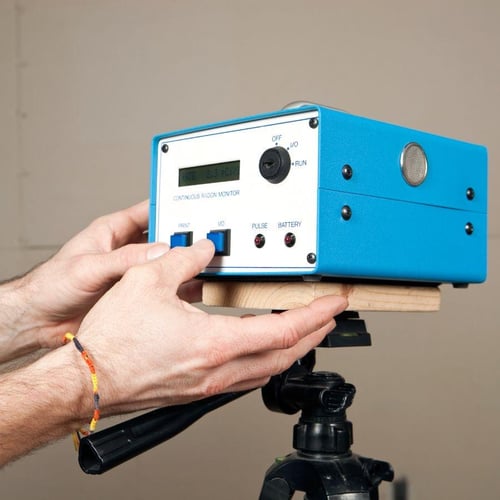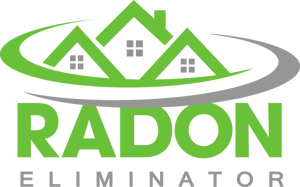Thankfully, lately, radon has been getting the attention it deserves, and it deserves a lot.
Besides smoking, it is the leading cause of lung cancer in the United States.
It is seemingly unavoidable because it is colorless, odorless, and virtually undetectable to the natural five senses.
Radon is a naturally occurring element found prominently in states surrounding Lake Erie, among others.
So, to sum up, Radon is a potentially lethal gas that you cannot naturally observe, and you may have already been exposed to it.
So yes, it is very fortunate this health risk is receiving its due notoriety.
Thankfully, at Radon Eliminator, we have gotten the radon testing process down to a science.
There are very few variables when it comes to performing a successful test. However, radon mitigation is a different story.
The story may be different, but the ending remains the same.
The expert radon mitigation professionals at Radon Eliminator know how to successfully lower radon levels in homes and keep the residents of any building safe from the dangers of radon exposure.
However, unlike our testing process, multiple ways to mitigate a home exist.
Continue reading this article to learn all about the four main types of Radon Mitigation utilized by our radon mitigation specialists.
Table of Contents
- Why Mitigations Are Necessary
- Basics of a Mitigation System
- Sub Slab Mitigation
- Basement Mitigation
- Crawl Space
- Sump Pump
- Schedule Your Mitigation Today
Why Mitigations Are Necessary

First, let's discuss why radon mitigation systems are even necessary in the first place.
We have already established that radon gas is dangerous and harmful.
But why is it a problem in the first place?
Radon occurs naturally in the ground and has been since the beginning of the world. However, it has only been recently that we have become more conscious of our impact on the planet.
Traditionally, indoor spaces have been better ventilated, and whenever radon gas would come up through the foundation, it would vent out naturally.
Recently, we have been trying to be more eco-friendly and have ensured our homes are sealed as tightly as possible to avoid wasting our resources.
However, it is not just our air conditioning or heating being sealed in, but naturally occurring radon gas.
A radon mitigation system creates a controlled vent in your foundation and, with an accompanying PVC pipe pathway, safely vents the radon outside the house and into the atmosphere.
Basics of a Mitigation System

Even though there are four different ways for radon professionals to perform mitigation, the nuts and bolts of each are all the same.
Mitigation involves drilling a hole into or around the foundation to reach the trapped radon gas below.
From there, the hole is sealed and attached to a radon fan, which pulls the radon out of the ground through a line of PVC piping and up above the building.
That is universal. However, we see the differences in the actual application of this process.
Read on about the four most common mitigation system installations.
Sub Slab Mitigation

Sub-slab depressurization is the first option available from Radon Eliminator.
Simply defined, this type of house has a foundation type that extends down below the ground floor.
Only poured concrete is on the ground level; no basement floor or crawl space exists.
Our radon mitigation experts will drill around the perimeter of the building's foundation from the outside, then use an exhaust fan and some radon pipe to safely vent high levels of radon gas into the outside air.
We have refined this simple procedure across many thousands of mitigations.
We've got you covered even if your house has concrete slabs.
Reach out to Radon Eliminator right away.
Basement Mitigation

Basement mitigation is another area of expertise for Radon Eliminator.
This method is similar to sub-slab mitigation, which involves venting radon gas by digging through the foundation of the basement floor.
The primary distinction between the two forms of mitigation is the presence of an additional layer between the foundation and the ground floor.
However, in most cases, the hole required to vent the radon can be drilled from inside the house rather than outside, giving you and your family more options for where to put the radon suction pipe.
Crawl Space

Many houses don't have basements or sub-slabs. Instead, they have a crawlspace under their home.
Homes with crawl spaces are similar to the mitigation process for the home types mentioned above.
In this case, we employ a countermeasure known as block wall depressurization.
The technical word may sound intimidating, but it means that with this approach to radon mitigation, we may now more easily and effectively vent the harmful radon gas that collects beneath your home.
It's one method our expert radon mitigation team uses, among many others.
We can run the PVC piping and radon fan from your crawlspace through the attic to the outside of your house, depending on how your property is designed.
No matter the concentration of radon, we can improve indoor air quality and mitigate harmful radon levels with Block Wall Depressurization.
Sump Pump

Last but not least, we can lower radon concentrations with sump pump mitigation.
This countermeasure is known in the field as drain tile depressurization.
This mitigation basically asks, "Why reinvent the wheel?"
There may already be a drilled hole in the basement or crawl area.
We can protect the house from indoor radon levels by blocking off the sump pump and placing our gear over the existing wiring.
This radon reduction technique allows you to accomplish two goals at once.
Schedule Your Mitigation Today

Radon is a legitimate concern, to be sure.
However, there is nothing to be afraid of.
The radon mitigation experts at Radon Eliminator have installed thousands of quality radon mitigation systems, which makes them experts at determining the best way to lower radon levels inside a home.
Whether or not you have a basement or a crawlspace, a sub-pump, or a sub-slab, we know how to make your home safe from the dangers of radon gas.
If you are looking for effective radon mitigation methods, you have come to the right place.
To schedule an appointment with the best radon contractors in your area, click on the link below now.





